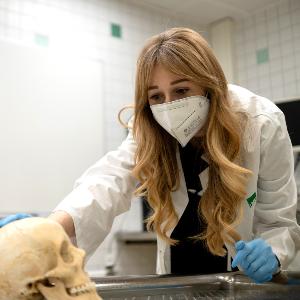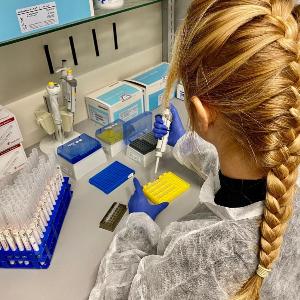CSI: LMU
15 Feb 2022
Dr. Marta Diepenbroek is a forensic scientist at the Institute of Legal Medicine. In the interview, she talks about the truth behind crime series, her research, and what skills prospective forensic scientists should have.
15 Feb 2022
Dr. Marta Diepenbroek is a forensic scientist at the Institute of Legal Medicine. In the interview, she talks about the truth behind crime series, her research, and what skills prospective forensic scientists should have.

© Mayla Joy Wind / LMU
Most people probably imagine forensic scientists in white overalls, searching through crime scenes. How close is that to reality?
Marta Diepenbroek: There is some truth to that, but it is actually not very common for a forensic scientist to go to the crime scene – especially if you are not employed by the police. It is usually the crime scene investigators who take care of that. Forensic scientists then work with the stains back at the lab.
For me personally: My lab is my kingdom! (laughs)
What does case work look like for you personally?
Marta Diepenbroek: The lab is where my part of the work starts, even though it is very important to be informed about the details of the case itself. We cannot analyze the samples without knowing their background and being aware of any potential difficulties in understanding the results.
Lab work can be extremely hectic and calming at the same time. Very often I will put on classical or, depending on my mood, rock music in the background. You can never allow your thoughts to wander. You must stay focused the whole time, because some evidence can only be collected once . Also, your work could influence someone's future – if someone is found guilty, for instance.
I have certain skills because I can analyze DNA, and I want to use these skills to make the world better.Marta Diepenbroek, Forensikerin am Institut für Rechtsmedizin der LMU
2:30 Min. | 15 Feb 2022
That sounds like a heavy responsibility …
Marta Diepenbroek: I try to see it from a different perspective: I have certain skills because I can analyze DNA, and I want to use these skills to make the world better. If someone has committed a crime, I want that person to be brought to account for it. And if someone is innocent, I am there to help exonerate them. If a family has been missing their daughter for twenty years, I am there to give them their daughter back. I try to be aware of and think about the responsibility, but you also have to find a balance and be able to tune it out so that it does not become too emotionally overwhelming.
What made you choose forensics in the first place?
Marta Diepenbroek: I think there was never any other option for me than to become a forensic scientist. At school, my two main interests were history and biology. But I decided to pursue biotechnology at university back in Poland, because it seemed like the more economically responsible choice. I didn't like it at all, especially the technological aspects. However, we had a lecturer who showed us applications for DNA in forensics, and that was fascinating to me.
And you knew then that you wanted to work in forensics?
Marta Diepenbroek: Not at that moment. I tried to attend a summer school at the forensic institute in my home city, in the DNA lab. I wasn’t able to do so, but they did offer me a spot in the toxicology department – which I also didn’t want to do because I hated chemistry! But I thought that at least it is in the same building. I didn’t give up and went to the DNA department over and over again, and finally they invited me to a seminar where they showed what they were working on. Their work included exhuming and genetically identifying German and Russian soldiers who had fallen in World War II. That was the day when I said, OK, this is what I'm going to do with my life.
Was that also the kind of work you started with?
Marta Diepenbroek: As a PhD student, I mostly worked with bones. I spent whole days cleaning them, crushing them in liquid nitrogen and extracting DNA from them. I also spent a lot of time in the field, recovering bones. But I also taught myself anthropology, with some help from experienced colleagues. I really wanted to be able to put all the bones together and understand, if, for example, a bone was broken before or after death. Those years in the field gave me a lot of valuable experience, but I never stopped working in the lab either.
We have plenty of great scientists in this field who are developing new methods to predict whether the perpetrator had freckles or curly or straight hair, for example! Even a person’s biological age can be predicted from DNA evidence.Marta Diepenbroek, Forensikerin am Institut für Rechtsmedizin der LMU
Was there any fieldwork that stood out for you?
Marta Diepenbroek: My colleagues and I worked at a special archeological site that resulted in the discovery of human remains at the former Nazi camp in Sobibor. That project was very demanding, both scientifically and emotionally. Confirming that the victims were Jewish was the most important thing I have ever done. This work was part of a wider project that still brings a lot of memories to the surface. During one exhumation, there was a skeleton that I will always remember. I found it in a single grave with a bullet in its skull and a little necklace with the image of Mary around its neck. I can still remember the number that was assigned to this skeleton. Some colleagues and I analyzed the DNA from the remains, and we got a match with his daughter. The victim was a civilian and had been executed, probably by the Gestapo. After being missing for 70 years, we were able to give his family closure.
At LMU you do case work for the police, but you also do research. What are you currently working on?
Marta Diepenbroek: When I came to LMU, my postdoctoral research focused on implementing a new technology known as massively parallel sequencing. This method opens new doors in forensics and allows us, for example, to analyze DNA markers that can help predict a person’s biogeographical ancestry and phenotype, i.e. their physical appearance. This technology is still pretty new and it needs more evaluation, especially if we want to use it in the context of law enforcement! Over the last three years, we have been developing own prediction tool that corresponded to our specific needs. We are now able to use it in our routine work.
Over this time, we have discovered many things. We have established our own workflow and guidelines for interpreting the results.

"My lab is my kingdom!", laughs Marta Diepenbroek. This is where she spends much of her time.
What are the most exciting developments in forensic science?
Marta Diepenbroek: For me, forensic DNA phenotyping, definitely! But I think many of my colleagues would say something else. When I entered forensics, the science was changing fast. It was probably similar to the 1980s, when DNA first became a thing. When I was doing my PhD and I first learned about this technology that might be able to predict what a person looked like or where he or she came from genetically, I really wanted to work with it! Forensic DNA phenotyping has already opened new doors in crime scene investigation. In Germany, we are currently only allowed to predict someone’s eye, hair and skin color. But in this field, we have plenty of great scientists who are developing new methods to predict whether the perpetrator had freckles or curly or straight hair, for example! Even a person’s biological age can be predicted from DNA evidence. We are still not at CSI levels of prediction, but we are getting there. (laughs)
When DNA or even blood work was introduced to police work and the legal system, there was a lot of skepticism about it. Is it the same with these new advances in phenotyping?
Marta Diepenbroek: I think that when forensic DNA phenotyping was first introduced, many people doubted whether it even made sense to explore this new direction. It is expensive, it is complicated and there is a lot more data to analyze. I have to admit that the methods are maybe not yet as perfect as everyone would like them to be. But if we stopped working on them, they would never get better. In the days before forensic DNA phenotyping, you could only analyze non-coding elements of DNA – those elements that come with no specific information about an individual. You can imagine them as a series of numbers. On their own, they don’t tell you anything. But if you find the same number at a crime scene and on your suspect, you suddenly have a match.
Would you like to see more in-depth analyses like phenotyping become admissible?
Marta Diepenbroek: It’s complicated because there are lots of ethical concerns. These new methods are called investigative leads: They just lead you in some direction, which means they can be more or less freely interpreted. And the question is whether the police will be able to interpret them properly. Is there the possibility that the data could be used to target minorities? Could the data be wrongly or over-interpreted? Can forensic scientists help the police with data interpretation? Should we be allowed to? There are a lot of questions that still need answering.
On the other hand, this approach could help with investigations and checking the reliability of eyewitnesses, for example. Because, in the end, DNA itself has no agenda and doesn’t lie. We just have to learn how to understand it better.
I can look at pasta while cooking, be silent for ten seconds and then start getting excited and talking about an experiment I have done.Marta Diepenbroek, Forensic scientists at the Institut für Rechtsmedizin of LMU
Being able to help solve crimes sounds like rewarding work. What skills should people possess who want to become forensic scientists themselves?
Marta Diepenbroek: Do you know what DNA is and get really excited about it? Then I say go for it! (laughs) Back when I started to get into forensics, I had no idea about it. I was just a student with some knowledge of molecular biology.
Having a sense of adventure certainly helps. But in the end, you just need to find yourself a good mentor – luckily, I did – and be passionate about the field. You have to be excited about every case you solve, about every identification job you do.
You certainly seem passionate about your job!
Marta Diepenbroek: I love it! There is really no line between my personal life and my work life, however that sounds! My husband says I need a maximum of 15 minutes of chatting to start talking about my work. I can look at pasta while cooking, be silent for ten seconds and then start getting excited and talking about an experiment I have done. That is just the way it is for me. But of course, I also have hobbies. Everything to do with mountains, cooking and loads of other stuff. (laughs)
Do you still watch crime shows like CSI or the German series Tatort?
Marta Diepenbroek: Absolutely. I have never stopped watching shows or reading about crime. I just don't get disturbed by many things anymore, and I have stopped judging fiction for depicting things that are not true. Sometimes it makes me laugh, but it’s the mystery that always keeps me hooked.
But if you want to learn something about forensics, I would rather recommend the David Hunter books by Simon Beckett. They focus more on the anthropology side of forensics but are pretty accurate and exciting!